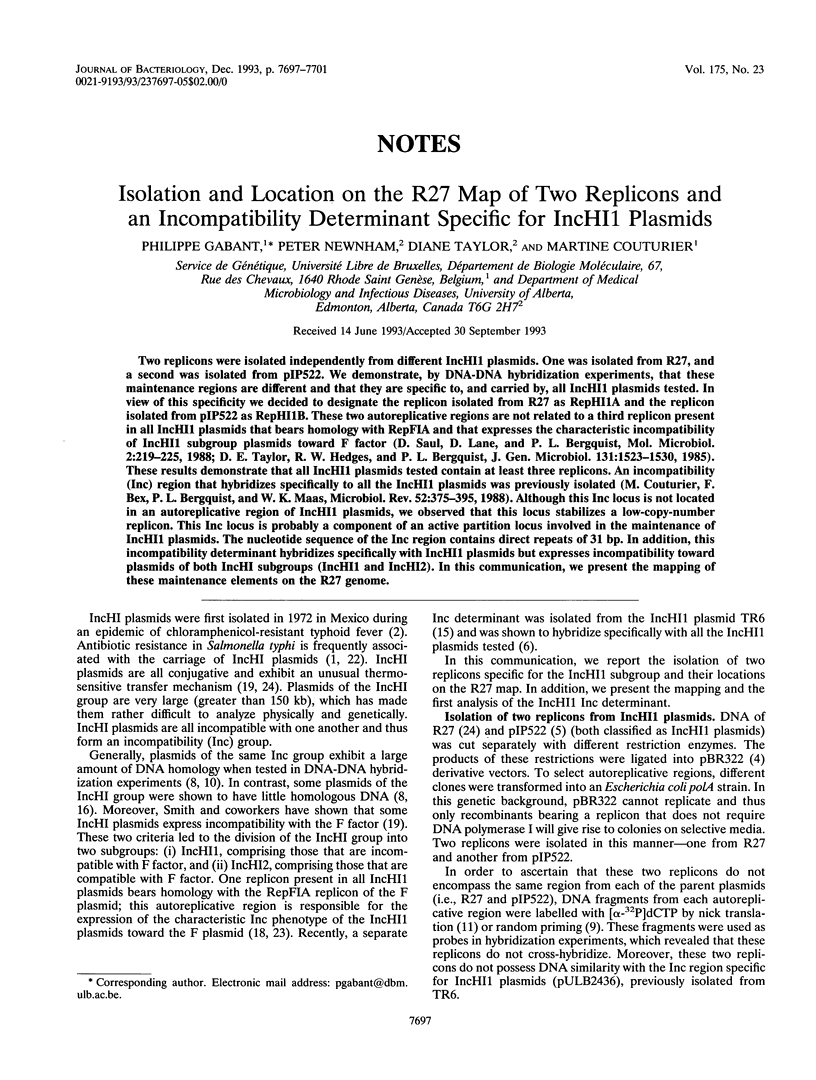Abstract
Two replicons were isolated independently from different IncHI1 plasmids. One was isolated from R27, and a second was isolated from pIP522. We demonstrate, by DNA-DNA hybridization experiments, that these maintenance regions are different and that they are specific to, and carried by, all IncHI1 plasmids tested. In view of this specificity we decided to designate the replicon isolated from R27 as RepHI1A and the replicon isolated from pIP522 as RepHI1B. These two autoreplicative regions are not related to a third replicon present in all IncHI1 plasmids that bears homology with RepFIA and that expresses the characteristic incompatibility of IncHI1 subgroup plasmids toward F factor (D. Saul, D. Lane, and P. L. Bergquist, Mol. Microbiol. 2:219-225, 1988; D. E. Taylor, R. W. Hedges, and P. L. Bergquist, J. Gen. Microbiol. 131:1523-1530, 1985). These results demonstrate that all IncHI1 plasmids tested contain at least three replicons. An incompatibility (Inc) region that hybridizes specifically to all the IncHI1 plasmids was previously isolated (M. Couturier, F. Bex, P. L. Bergquist, and W. K. Maas, Microbiol. Rev. 52:375-395, 1988). Although this Inc locus is not located in an autoreplicative region of IncHI1 plasmids, we observed that this locus stabilizes a low-copy-number replicon. This Inc locus is probably a component of an active partition locus involved in the maintenance of IncHI1 plasmids. The nucleotide sequence of the Inc region contains direct repeats of 31 bp. In addition, this incompatibility determinant hybridizes specifically with IncHI1 plasmids but expresses incompatibility toward plasmids of both IncHI subgroups (IncHI1 and IncHI2). In this communication, we present the mapping of these maintenance elements on the R27 genome.
Full text
PDF




Images in this article
Selected References
These references are in PubMed. This may not be the complete list of references from this article.
- Anderson E. S., Smith H. R. Chloramphenicol resistance in the typhoid bacillus. Br Med J. 1972 Aug 5;3(5822):329–331. doi: 10.1136/bmj.3.5822.329. [DOI] [PMC free article] [PubMed] [Google Scholar]
- Anderson E. S. The problem and implications of chloramphenicol resistance in the typhoid bacillus. J Hyg (Lond) 1975 Apr;74(2):289–299. doi: 10.1017/s0022172400024360. [DOI] [PMC free article] [PubMed] [Google Scholar]
- Austin S., Nordström K. Partition-mediated incompatibility of bacterial plasmids. Cell. 1990 Feb 9;60(3):351–354. doi: 10.1016/0092-8674(90)90584-2. [DOI] [PubMed] [Google Scholar]
- Chabbert Y. A., Gerbaud G. R. Surveillance épidémiologique des plasmides responsables de la résistance au chloramphénicol de Salmonella typhi. Ann Microbiol (Paris) 1974 Feb-Mar;125A(2):153–166. [PubMed] [Google Scholar]
- Couturier M., Bex F., Bergquist P. L., Maas W. K. Identification and classification of bacterial plasmids. Microbiol Rev. 1988 Sep;52(3):375–395. doi: 10.1128/mr.52.3.375-395.1988. [DOI] [PMC free article] [PubMed] [Google Scholar]
- De Lucia P., Cairns J. Isolation of an E. coli strain with a mutation affecting DNA polymerase. Nature. 1969 Dec 20;224(5225):1164–1166. doi: 10.1038/2241164a0. [DOI] [PubMed] [Google Scholar]
- Feinberg A. P., Vogelstein B. A technique for radiolabeling DNA restriction endonuclease fragments to high specific activity. Anal Biochem. 1983 Jul 1;132(1):6–13. doi: 10.1016/0003-2697(83)90418-9. [DOI] [PubMed] [Google Scholar]
- Grindley N. D., Humphreys G. O., Anderson E. S. Molecular studies of R factor compatibility groups. J Bacteriol. 1973 Jul;115(1):387–398. doi: 10.1128/jb.115.1.387-398.1973. [DOI] [PMC free article] [PubMed] [Google Scholar]
- Maniatis T., Jeffrey A., Kleid D. G. Nucleotide sequence of the rightward operator of phage lambda. Proc Natl Acad Sci U S A. 1975 Mar;72(3):1184–1188. doi: 10.1073/pnas.72.3.1184. [DOI] [PMC free article] [PubMed] [Google Scholar]
- Newnham P. J., Taylor D. E. Genetic analysis of transfer and incompatibility functions within the IncHI plasmid R27. Plasmid. 1990 Mar;23(2):107–118. doi: 10.1016/0147-619x(90)90029-c. [DOI] [PubMed] [Google Scholar]
- Nordström K., Austin S. J. Mechanisms that contribute to the stable segregation of plasmids. Annu Rev Genet. 1989;23:37–69. doi: 10.1146/annurev.ge.23.120189.000345. [DOI] [PubMed] [Google Scholar]
- Novick R. P. Plasmid incompatibility. Microbiol Rev. 1987 Dec;51(4):381–395. doi: 10.1128/mr.51.4.381-395.1987. [DOI] [PMC free article] [PubMed] [Google Scholar]
- Pohl P., Lintermans P., Corbion B., Gledel J., Minor L. L., Chasseur M. L., Ghysels G. Plasmides du groupe d'incompatibilité H chez des souches de Salmonella multirésistantes. Ann Microbiol (Paris) 1981 Nov-Dec;132 B(3):399–404. [PubMed] [Google Scholar]
- Roussel A. F., Chabbert Y. A. Taxonomy and epidemiology of gram-negative bacterial plasmids studied by DNA-DNA filter hybridization in formamide. J Gen Microbiol. 1978 Feb;104(2):269–276. doi: 10.1099/00221287-104-2-269. [DOI] [PubMed] [Google Scholar]
- Sanger F., Nicklen S., Coulson A. R. DNA sequencing with chain-terminating inhibitors. Proc Natl Acad Sci U S A. 1977 Dec;74(12):5463–5467. doi: 10.1073/pnas.74.12.5463. [DOI] [PMC free article] [PubMed] [Google Scholar]
- Saul D., Lane D., Bergquist P. L. A replication region of the IncHI plasmid, R27, is highly homologous with the RepFIA replicon of F. Mol Microbiol. 1988 Mar;2(2):219–225. doi: 10.1111/j.1365-2958.1988.tb00023.x. [DOI] [PubMed] [Google Scholar]
- Smith H. R., Grindley N. D., Humphreys G. O., Anderson E. S. Interactions of group H resistance factors with the F factor. J Bacteriol. 1973 Aug;115(2):623–628. doi: 10.1128/jb.115.2.623-628.1973. [DOI] [PMC free article] [PubMed] [Google Scholar]
- Southern E. M. Detection of specific sequences among DNA fragments separated by gel electrophoresis. J Mol Biol. 1975 Nov 5;98(3):503–517. doi: 10.1016/s0022-2836(75)80083-0. [DOI] [PubMed] [Google Scholar]
- Taylor D. E., Brose E. C. Restriction endonuclease mapping of R27 (TP117), an incompatibility group HI subgroup 1 plasmid from Salmonella typhimurium. Plasmid. 1985 Jan;13(1):75–77. doi: 10.1016/0147-619x(85)90058-7. [DOI] [PubMed] [Google Scholar]
- Taylor D. E., Hedges R. W., Bergquist P. L. Molecular homology and incompatibility relationships between F and IncH1 plasmids. J Gen Microbiol. 1985 Jun;131(6):1523–1530. doi: 10.1099/00221287-131-6-1523. [DOI] [PubMed] [Google Scholar]
- Wang Y. Double-stranded DNA sequencing with T7 polymerase. Biotechniques. 1988 Oct;6(9):843–845. [PubMed] [Google Scholar]
- Yanisch-Perron C., Vieira J., Messing J. Improved M13 phage cloning vectors and host strains: nucleotide sequences of the M13mp18 and pUC19 vectors. Gene. 1985;33(1):103–119. doi: 10.1016/0378-1119(85)90120-9. [DOI] [PubMed] [Google Scholar]




